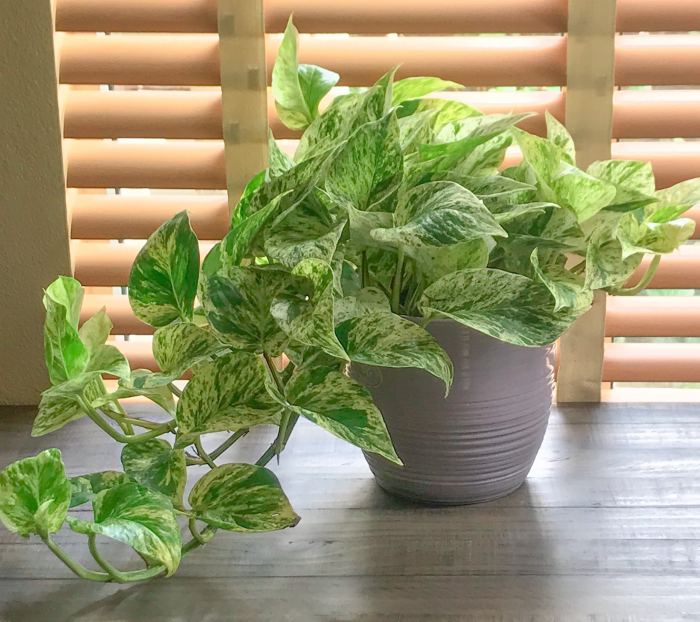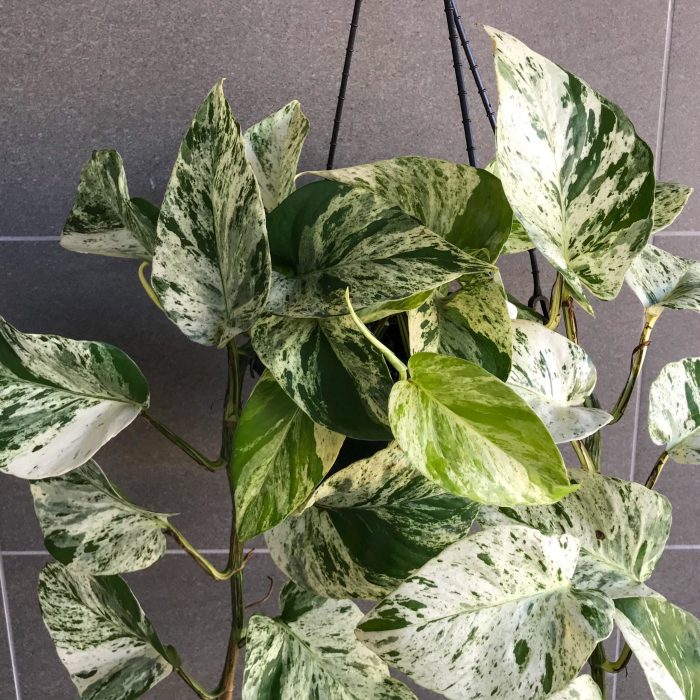As the pothos indoor plant takes center stage, this comprehensive guide delves into its captivating world, providing a wealth of knowledge to cultivate a thriving indoor oasis.
From its diverse varieties to its remarkable benefits, this article explores every aspect of pothos care, empowering readers to create vibrant and healthy indoor environments.
Pothos Plant Overview

The Pothos plant, scientifically classified as Epipremnum aureum, is a popular houseplant known for its resilience and ease of care. Originating from the Solomon Islands, Pothos is a member of the Araceae family and is widely cultivated for its attractive foliage and air-purifying properties.
Pothos plants exhibit a range of variations, each with its unique characteristics. The most common type is the Golden Pothos, featuring heart-shaped leaves with vibrant yellow variegation. Other popular varieties include the Marble Queen, with white and green marbled leaves; the Neon Pothos, with bright chartreuse-colored leaves; and the Manjula Pothos, known for its variegated leaves with silvery-green and creamy-white patterns.
Growth Habit
Pothos plants are vigorous climbers, growing rapidly with minimal care. They can be trained to climb trellises or poles, or allowed to cascade gracefully from hanging baskets. Their trailing stems can reach lengths of up to 10 feet, making them an ideal choice for adding a touch of greenery to vertical spaces.
Environmental Benefits
In addition to their aesthetic appeal, Pothos plants are also known for their air-purifying abilities. Studies have shown that they can effectively remove harmful toxins, such as benzene, formaldehyde, and trichloroethylene, from the air. This makes them a valuable addition to homes and offices, contributing to improved indoor air quality.
Care Requirements
Pothos plants are generally low-maintenance and can tolerate a wide range of conditions. They prefer bright, indirect light but can also adapt to lower light levels. Watering should be moderate, allowing the soil to dry out slightly between waterings. Fertilizing once a month during the growing season can help promote healthy growth.
Pothos Plant Care: Pothos Indoor Plant
Providing optimal growing conditions is crucial for the health and well-being of Pothos plants. Understanding their light requirements, temperature range, and humidity levels is essential for successful cultivation.
Pothos plants thrive in bright, indirect light. Direct sunlight can scorch their leaves, leading to discoloration and damage. East- or west-facing windows provide ideal lighting conditions.
Regarding temperature, Pothos plants prefer warm environments within the range of 65-85°F (18-29°C). They are sensitive to cold drafts and extreme temperature fluctuations.
Humidity levels should be maintained at a moderate to high level for Pothos plants. Regular misting, the use of a humidifier, or placing the plant on a pebble tray filled with water can increase humidity.
Watering Techniques
Watering Pothos plants appropriately is essential to prevent overwatering or underwatering. Allow the top 2-3 inches of soil to dry out between waterings.
When watering, thoroughly soak the soil until water drains from the drainage holes. Avoid leaving the plant sitting in water, as this can lead to root rot.
Fertilizing
Fertilizing Pothos plants during the growing season (spring and summer) promotes healthy growth. Use a balanced liquid fertilizer diluted to half strength and apply it monthly.
Pruning
Regular pruning helps maintain the shape and size of Pothos plants. Remove any dead, damaged, or overgrown stems. Pruning also encourages bushier growth.
Repotting
Repotting Pothos plants is necessary as they outgrow their current containers. Use a pot that is slightly larger than the previous one and ensure it has adequate drainage holes.
Pothos indoor plants are known for their easy-care nature and ability to thrive in low-light conditions. If you’re looking for a way to add greenery to your home without the hassle of watering and sunlight, artificial hanging plants indoor can be a great alternative.
These plants are made from high-quality materials that mimic the look and feel of real plants, and they can be used to create a lush, tropical atmosphere in any room. And like pothos indoor plants, artificial hanging plants indoor are perfect for adding a touch of greenery to dark corners or rooms with limited natural light.
When repotting, gently loosen the roots and remove any damaged or rotten ones. Replant the Pothos in a well-draining potting mix and water thoroughly.
Pothos, a popular indoor plant known for its trailing vines, thrives in low light conditions. If you’re seeking additional options for low-light spaces, consider exploring best hanging plants for low light . From the graceful String of Hearts to the delicate Maidenhair Fern, these plants will add a touch of greenery and purify the air in your dimly lit areas.
However, pothos remains a versatile choice, offering a wide range of varieties and easy maintenance.
Pothos Plant Propagation
Propagating pothos plants is a simple and rewarding way to increase your plant collection. There are several methods for propagating pothos plants, including stem cuttings, air layering, and division.
Stem Cuttings
Stem cuttings are the most common method for propagating pothos plants. To take a stem cutting, use a sharp knife or scissors to cut a 4-6 inch section from a healthy stem. Remove the leaves from the bottom 1-2 inches of the stem and then dip the end of the cutting in rooting hormone.
Plant the cutting in a pot filled with a well-draining potting mix. Keep the soil moist and place the pot in a warm, bright location. Roots will typically develop within 2-3 weeks.
Air Layering
Air layering is a method of propagating pothos plants that involves rooting a stem while it is still attached to the parent plant. To air layer a pothos plant, make a small cut in the stem and then wrap the cut area with moist sphagnum moss.
Cover the sphagnum moss with plastic wrap and secure it in place with tape. Keep the sphagnum moss moist and within 6-8 weeks, roots will develop at the cut site.
Division
Division is a method of propagating pothos plants that involves separating the plant into smaller sections. To divide a pothos plant, carefully remove the plant from its pot and then gently pull the plant apart at the roots.
Each section should have at least 3-4 leaves and a healthy root system. Plant the divisions in individual pots filled with a well-draining potting mix.
Pothos Plant Benefits and Uses

Pothos plants, known for their lush foliage and easy maintenance, offer a myriad of benefits and uses that make them a popular choice for interior design and home décor. These plants not only enhance the aesthetic appeal of spaces but also contribute to well-being and environmental health.
Air Purification
Pothos plants are renowned for their ability to purify the air. Studies have shown that they effectively remove harmful pollutants, such as benzene, formaldehyde, and carbon monoxide, from the indoor environment. This makes them an excellent choice for homes, offices, and other indoor spaces where air quality may be compromised.
Stress Reduction
The presence of plants in indoor environments has been linked to reduced stress levels. Pothos plants, with their trailing vines and lush foliage, create a calming and serene atmosphere. Their aesthetic appeal and ability to purify the air can help alleviate stress and promote relaxation.
Aesthetic Appeal
Pothos plants are highly valued for their aesthetic appeal. Their variegated foliage, ranging from shades of green to cream and yellow, adds a touch of vibrancy to any space. They can be used in various ways to enhance the interior design, from hanging baskets to tabletop arrangements and vertical gardens.
Interior Design Uses
Pothos plants are versatile and can be incorporated into various interior design styles. Their trailing vines make them ideal for hanging baskets, adding a touch of greenery to high shelves or corners. They can also be arranged on tabletops or desks, bringing a sense of freshness and vitality to the workspace.
Vertical gardens, featuring Pothos plants, create a lush and inviting atmosphere while maximizing space.
Specific Room Enhancements
Pothos plants can enhance the ambiance of different rooms and spaces. In living rooms, they add a touch of greenery and create a cozy atmosphere. In bedrooms, their calming effect promotes relaxation and restful sleep. In offices, they help purify the air and reduce stress, creating a more productive work environment.
Troubleshooting Common Pothos Plant Issues
Pothos plants are generally easy to care for, but they can occasionally encounter problems. Here are some of the most common issues and how to fix them:
Yellowing Leaves
Yellowing leaves can be caused by a variety of factors, including overwatering, underwatering, nutrient deficiency, or lack of sunlight. To troubleshoot, check the soil moisture and adjust watering accordingly. Fertilize the plant regularly and ensure it receives bright, indirect light.
Brown Tips, Pothos indoor plant
Brown tips on Pothos leaves are often caused by underwatering or low humidity. Increase watering frequency and mist the plant regularly to increase humidity. Avoid placing the plant near heat sources or drafts.
Pests
Pothos plants can be susceptible to pests such as mealybugs, aphids, and spider mites. Inspect the plant regularly for signs of infestation and treat accordingly with insecticidal soap or neem oil.
Preventing Future Problems
To prevent future problems, provide your Pothos plant with the proper care it needs. Water regularly, fertilize monthly, and ensure it receives bright, indirect light. Keep the plant away from heat sources and drafts, and check for pests regularly. By following these tips, you can help your Pothos plant thrive.
End of Discussion

Whether you’re a seasoned plant enthusiast or a budding gardener, this guide equips you with the knowledge and inspiration to transform your indoor space with the beauty and tranquility of pothos plants.
Essential Questionnaire
How often should I water my pothos plant?
Water your pothos plant when the top inch of soil feels dry to the touch. Avoid overwatering, as this can lead to root rot.
What are the benefits of having a pothos plant indoors?
Pothos plants help purify the air by removing toxins such as formaldehyde and benzene. They can also reduce stress and create a sense of tranquility.
How do I propagate a pothos plant?
Pothos plants can be propagated through stem cuttings. Simply take a cutting from a healthy stem and place it in water or soil. Roots will develop within a few weeks.